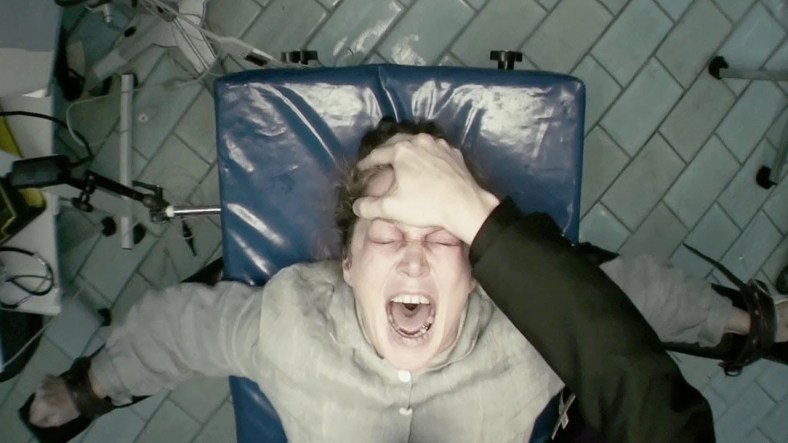Disturbing the 2012 Box Office with ‘The Devil Inside’

It ended with a text card. “For more information about the ongoing investigation visit www.TheRossiFiles.com.” It’s what every moviegoer wants—a homework assignment after seeing some throwaway possession yarn in early January. With the holidays sated and the goodwill dwindling, The Devil Inside had a chance to ignite the 2012 box office. And it did. Any hint of sarcasm in the preceding statement is wholly unintentional. With a meager budget of just $1 million, The Devil Inside, perhaps with the assistance of Old Scratch himself, managed a staggering haul just shy of $102 million. Not bad for something largely considered one of the worst horror movies of the century.
Opening with some The Blair Witch Project inspired pseudo-realism— The Vatican does not authorize the recording of Roman Catholic exorcisms/The Vatican did not endorse this film nor aid in its completion—The Devil Inside firmly commits to its gambit. Most of it isn’t true, mind you—20/20 aired a church-sanctioned exorcism live on television in 1991. But there’s something brazenly endearing about how earnestly The Devil Inside undulates the rough sketches of reality. This movie really, really wants you to think it’s real.
Though I was but a wee horror fan at the time, I have it on good authority (contemporaneous authority), that while The Blair Witch Project has reached mythic levels of cinematic deception (deservedly so), upon release, very few people stumbled unsuspectingly into the theater, believing the footage they were watching was real. Even Ghostwatch, another infamous found footage shocker, has a legacy considerably more complicated than the public writ large simply believing it to be real independent of other, mitigating factors. Audiences are not dumb. While they might not be keen to believe that found footage is bonafide found footage, the subgenre achieves profound success in the illusion of it all.
Like its forebears, The Devil Inside is abounding with facsimiles of the real world. It opens with distorted 911 audio. Its gore is brief and shocking. The camera plays an entire round of Wii Sports Resort while the actors incidentally stumble in and out of frame, especially once the demonic shenanigans fervently accelerate. It’s that same facsimile that yields most of the power. It’s not real, but it feels real enough. It allows audience members to escape however briefly, ignoring pressing questions such as: why has a professional editor assembled this footage, why is there a soundtrack, and why have I seen Isabella Rossi (Fernanda Andrade) in Let the Right One In on Showtime?
Over at Paste, Matt Donato adroitly reviewed The Devil Inside’s failed commitment to capitalizing on its half-truths. With fake comments and a ludicrously designed website, it was clear, or ostensibly clear, that The Devil Inside prioritized its gimmick over the movie itself. The most common criticism lobbed against it was that the movie was really half a movie. What audiences really wanted to see was memorialized in JavaScript online.
Yet, The Devil Inside was a success, no doubt about it. Before release, Paranormal Activity 3 was the last theatrical horror outing on October 21. Before that, it was The Thing on October 14. For niche audiences, Human Centipede 2: Full Sequence released in limited theaters on October 7. The whole year, in fact, was pretty grim for horror. Make no mistake, several certified bangers were released in 2011—Insidious in April, Scream 4 that same month. Yet, only 13 horror movies topped $1 million in grosses. Even then, only Paranormal Activity 3 topped $100 million. Audiences needed something.
And, for better or worse, William Brent Bell’s The Devil Inside was there. The plot, for those who have read this far unfamiliar with it, follows Andrade’s Isabella as she films a documentary about a triple homicide committed by her mother, a woman conspicuously, unequivocally possessed by the devil. This isn’t The Exorcist’s slow descent. Suzan Crowley’s Maria Rossi phones the police, whispering, “Three people… three people are dead. I… killed… them.” Yup. Possessed.
The intermittent moments are bits of exorcism-lite. Actors spout faux-Catechism nonsense about the urgency of exorcisms, a bunch of demonic psychobabble, and every cliché in the book. Then, just as The Devil Inside finds its grove, moving beyond first act exposition into territory that would distinguish it from its ilk (including The Rite, released just one year before), a car collides with traffic, the screen cuts to black, and the infamous text directions appear on screen.
Yet, The Devil Inside isn’t the dumpster fire of January horror it’s made out to be. It’s not terribly original, but Bell exhibits the same panache he did in last year’s Orphan: First Kill. Some of its demonic ramblings are pretty danged effective, too, especially for audiences of faith. And, perhaps most importantly, it likely shifted the trajectory of horror movie releases forever. The Devil Inside cost nothing and made millions. Good, bad, or indifferent, audiences flock to horror. 2022’s success with the likes of Nope, Scream, and Smile among several others is a result—directly and indirectly—of The Devil Inside’s success. It may have killed found footage for the time, but it undoubtedly saved the genre. Audiences demanded the devil in whatever form. Alongside some serviceable scares and grim thematic underpinnings, The Devil Inside’s delivered just that.
Categorized:Editorials News

